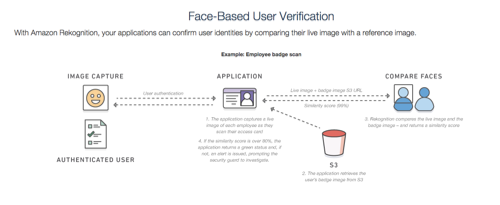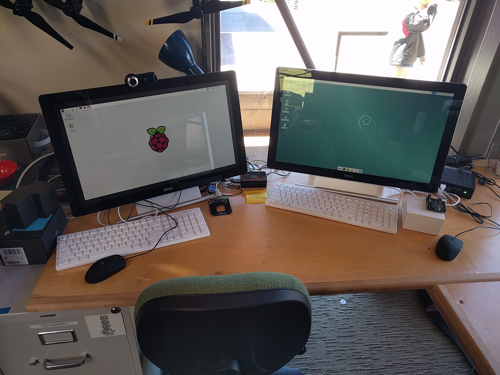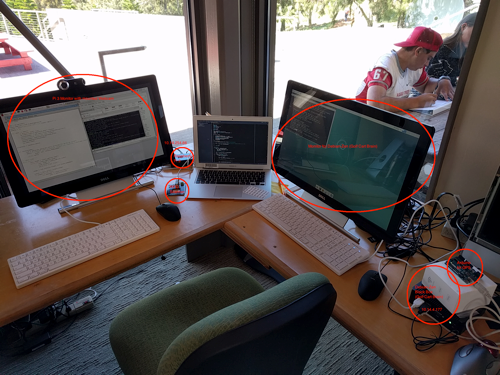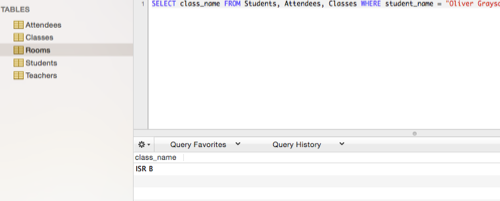Resources and Materials
Project Title: Vision Systems and Campus Automation
Project Scope: Classroom Attendance and Intra-campus Transport
Project Duration/timeline: 2016-2017 school year, possibly into 2018 (autonomous golf cart subproject)
Project partners (internal and external): Ilan Naibryf, partner for golf carts.
———————————Resources———————————
Materials (tools, equipment, supplies, locations, remote resources-be specific):
Automated Attendance System
-
Raspberry Pi 3 (rpi3-oliver-evil (pi)@10.14.254.6)
-
USB webcam
-
Phidget RFID reader
-
RFID cards
-
Eventually, access to the current HPA student attendance database
-
Duplicates of all of these, when large-scale distribution is possible
Autonomous Golf Cart
-
“Black box” computer (debian-zen (root)@10.14.4.177)
-
Phidget motor controllers
-
2 High-torque Pololu servos
-
Arduino Uno
-
Arduino GPS HAT
-
USB webcam
-
Small Elab golf cart
People (include response email from each resource person, agreeing to your materials/support request):
Ilan Naibryf:

Online resources (web pages, wikis, online programs):
Proposal (latest version)
Abstract: This project will focus on first creating an automated attendance system using a combination of Radio Frequency Identification (RFID) tags and facial recognition software. Once such a system has been implemented, the project will branch out into using the vision system for other purposes, such as an autonomous golf cart.
Project Name: Vision Systems and Campus Automation
Background: Working on this project, I would like to create an automatic attendance system that uses a combination of RFID tags and facial recognition with the Raspberry Pi. Initial prototypes of the RFID system for attendance have already been created by previous students such as Erin Evans and Miller White. I may use some of the hardware that they used, as it would be relatively simple to repurpose it for the system I have created.
Purpose: By the end of this project, I expect to have a working prototype of the RFID attendance system that can be deployed to select classrooms at this school. Some locations will also include a camera to improve accuracy via facial recognition. Additionally, I would like to have made significant progress on my autonomous golf cart, having all of the hardware in place with at least a remote-controlled option.
What will you measure: I will teach my computers to identify people and other objects in the world with machine learning and image manipulation software.
How will you measure it: I will test my programs by deploying them in various classrooms, including the Monlab Independent Science Research class.
Resources needed: For the attendance devices, my current prototype uses a Raspberry Pi 3, a USB webcam, and an RFID reader Phidget. Creating any more of these devices will require similar resources, although the Pi-specific camera “Picam” may be substituted to reduce price and more unobtrusive. For the autonomous golf cart, I will require the main brain of the robot - on of the “black box” computers running Debian; an Arduino connected to a GPS module; two high-torque servos, such as the one currently in the remote-controlled boat; a mechanism for controlling the accelerator; and a camera for course correction and visual recognition of hazards. I will work with several other people on this project as well: Zoë McGinnis would like to work on the facial recognition and attendance system, while Ilan Naibryf has agreed to work on the golf cart subproject with me.
Impact: The attendance system will enable more class time to be used on actual class and not on attendance done by the teacher. If attendance is not something they need to consider, then the first 5 minutes of class can be spent on teaching, instead of the human teacher’s valuable time being wasted on making sure all the students are there first. Time may be saved in other areas of campus as well, such as check-in for boarding students - the process could be made more expedient (and thus more likely for all to participate) with an automated system. Instead of requiring central meetings and delays interrupting students' work or free time, a reliable video/RFID system with instantaneous updates updates would be much more effective.
In a similar vein, the autonomous golf cart will save students time, as students will no longer need to spend their off periods or their time between classes to drive injured students around; an autonomous golf cart is also incapable of getting sidetracked or forgetting to pick someone up. If there were enough autonomous carts, the system might even become so efficient that students who were not injured could benefit from it as well, if they had a long walk to the other end of campus or somesuch.
Legacy: At the end of this project, a working automation system will be in place for attendance. While it is up to the school whether or not to use it in the long run, it will be available. Additionally, future students in Independent Science Research will be able to improve the system and make it more accurate, or faster, or change it to be more effective in some way I have not thought of.
With the golf cart, I expect to continue the project next year, as I do not anticipate having my final model finished by the end of the year. Once I graduate, the project will be available to any other student who wishes to improve its artificial intelligence, or has ideas for replicating the project or making it in some way more useful to the school.


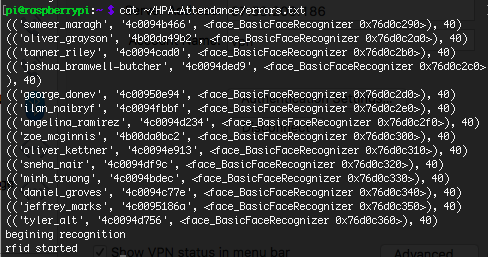
 I will finish the hardware for the hydroponic sensors on Friday, connecting the pH meter. I will also run tests of how often each can be polled without polarizing the water - this may take until next week.
I will finish the hardware for the hydroponic sensors on Friday, connecting the pH meter. I will also run tests of how often each can be polled without polarizing the water - this may take until next week.
